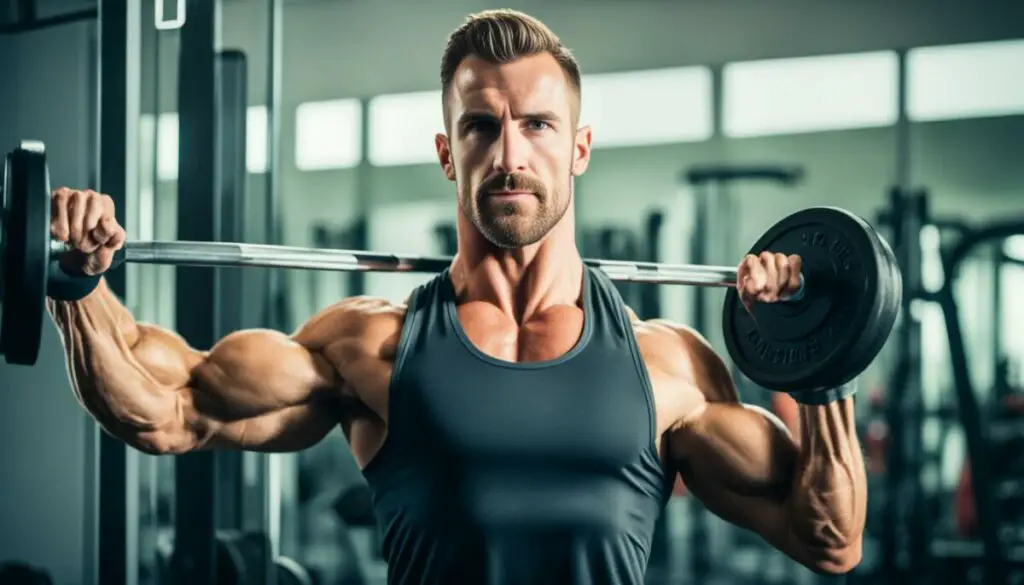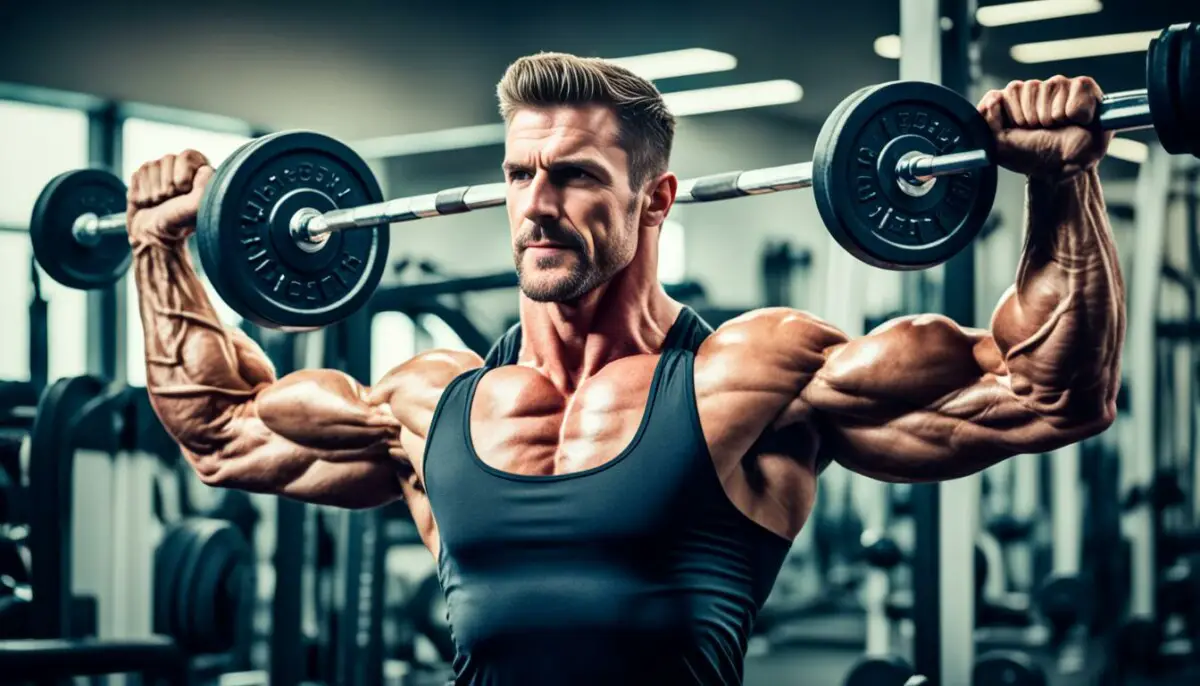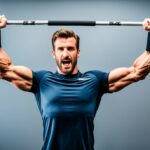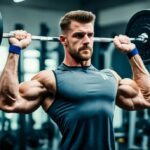Last Updated on 3 months by Francis
Reverse curls are a highly effective exercise for targeting specific muscle groups in the arms. In addition to working the biceps brachii and brachialis, reverse curls also engage the brachioradialis, a forearm muscle that helps to stabilize the movement. Incorporating reverse curls into your upper body workout can enhance arm strength and toning, making them a valuable exercise for strength training and muscle development.
Contents
Key Takeaways:
- Reverse curls target the biceps brachii, brachialis, and brachioradialis muscles.
- They are an excellent forearm exercise that promotes muscle development and stability.
- Reverse curls can be incorporated into upper body workouts for overall arm strength improvement.
- Strength training and resistance training enthusiasts can benefit from including reverse curls in their routines.
- Reverse curls are a versatile exercise that can be performed with various equipment.
How to Perform Reverse Curls for Bigger Biceps and Forearms

To effectively target your biceps and forearms and promote muscle development and upper body strength, reverse curls are a must-do exercise in your weightlifting routine. Below, we outline the proper technique for performing reverse curls:
- Grip a barbell with an overhand grip, ensuring your hands are shoulder-width apart.
- Plant your feet firmly on the ground and slightly bend your knees to maintain stability throughout the exercise.
- Keep your elbows close to your sides and begin curling the barbell up towards your shoulders.
- At the top of the movement, flex your wrists slightly to engage the forearms.
- Slowly lower the barbell back down to the starting position in a controlled manner.
- Repeat the movement for the desired number of reps.
This exercise effectively targets both the biceps and forearms, leading to increased muscle development and upper body strength. Incorporating reverse curls into your regular biceps and forearm exercises will help you achieve a more well-rounded muscle growth in your upper arms.
Remember to maintain proper form and technique throughout the exercise to maximize its benefits and prevent any potential injuries. By adding reverse curls to your workout routine, you can take your biceps and forearm training to the next level and see noticeable improvements in strength and muscle definition.
Benefits of Reverse Curls

Reverse curls offer several benefits for those looking to enhance their arm workouts. These benefits include:
- Targeting Multiple Muscle Groups: Reverse curls engage the biceps, forearms, and brachioradialis, providing a comprehensive upper arm workout. By incorporating this exercise into your routine, you can target multiple muscles simultaneously and promote overall upper arm definition.
- Improved Grip Strength: As reverse curls require a firm grip on the barbell, performing this exercise regularly can help strengthen your grip. This increased grip strength can be beneficial not only for weightlifting but also for any activities that require a strong and secure grasp.
- Correcting Muscle Imbalance: Many individuals naturally have muscle imbalances, where certain muscle groups are stronger than others. Reverse curls can help address these imbalances by targeting specific muscle groups, such as the brachioradialis, which often gets neglected during traditional bicep exercises.
- Reducing Elbow Pain: Reverse curls can alleviate elbow pain caused by repetitive motions or strain on the elbow joint. By strengthening the muscles surrounding the elbow, reverse curls can provide stability and support, reducing the risk of discomfort or injury.
- Enhanced Upper Arm Definition: Regularly incorporating reverse curls into your upper body workout routine can contribute to improved upper arm definition. By targeting the biceps, forearms, and brachioradialis, reverse curls can help sculpt and tone these muscles, creating a more defined and aesthetically pleasing appearance.
By understanding the benefits of reverse curls, you can make informed decisions about incorporating this exercise into your arm workouts, maximizing your results and achieving your fitness goals.
Reverse Curl Training Tips

To optimize your reverse curl training and maximize your results, consider the following exercise tips, grip techniques, and form recommendations:
1. Proper Grip Techniques
When performing reverse curls, the grip technique you use can significantly impact the effectiveness of the exercise. Consider these two grip options:
- Overhand Grip: This is the most common grip technique for reverse curls. Grasp the barbell with your palms facing downward, ensuring your hands are shoulder-width apart. This grip emphasizes the engagement of the biceps and forearms.
- Supinated Grip: Also known as an underhand grip, this variation involves holding the barbell with your palms facing upward. This grip places more emphasis on the brachialis and brachioradialis muscles.
Expert Tip: Experiment with both grip techniques to determine which one feels most comfortable and effective for your specific goals and preferences.
2. Maintaining Proper Form
Form is crucial when performing reverse curls to ensure you are targeting the intended muscle groups effectively and minimizing the risk of injury. Here are some key points to remember:
- Stance: Stand with your feet shoulder-width apart and maintain a slight bend in your knees. This will provide stability during the exercise.
- Elbow Position: Keep your elbows close to your sides throughout the movement. Avoid swinging or using momentum to lift the weight.
- Wrist Flexion: As you curl the barbell upward, flex your wrists slightly to engage the forearm muscles.
- Controlled Movement: Slowly lift the weight in a controlled manner, focusing on squeezing the targeted muscles. Avoid using excessive momentum or swinging the barbell.
Expert Tip: To further engage your core and stabilize your body during reverse curls, maintain a slight contraction in your abdominal muscles throughout the exercise.
3. Using Chalk for Better Grip
If you find that your grip strength is limiting the number of reps you can perform or compromising your form, using chalk can be beneficial. Chalk helps to reduce moisture on the hands, providing a better grip on the barbell and minimizing the risk of slippage.
Before using chalk, ensure that your training facility allows it and follow the proper application instructions to avoid excessive use.
4. Supersetting with Other Exercises
Supersetting is a training technique where you perform two exercises back-to-back without rest. Incorporating reverse curls into a superset can help to increase overall training volume, save time, and challenge your muscles in different ways.
Some exercises that pair well with reverse curls in a superset include hammer curls, overhead tricep extensions, or wrist curls.
Expert Tip: When supersetting, choose exercises that target different muscle groups to prevent overfatigue and maintain proper form throughout the superset.
By incorporating these reverse curl training tips into your workout routine, you can optimize your training sessions, improve your form, and enhance the effectiveness of the exercise for biceps and forearm development.
Reverse Curl Training Tips Summary
| Tips | Description |
|---|---|
| Proper Grip Techniques | Experiment with overhand and supinated grips to target different muscles |
| Maintaining Proper Form | Ensure correct stance, elbow position, wrist flexion, and controlled movement |
| Using Chalk for Better Grip | Chalk can enhance grip strength and reduce the risk of slippage |
| Supersetting with Other Exercises | Pair reverse curls with complimentary exercises for a more challenging workout |
Variations of Reverse Curls
While standard barbell reverse curls are effective, there are various variations you can incorporate into your workouts to add variety and target the muscles from different angles. These variations include:
Dumbbell Reverse Curls
Using dumbbells for reverse curls allows for a greater range of motion and independent arm movement. Hold a dumbbell in each hand, palms facing down, and curl the weight towards your shoulders while maintaining control and proper form.
Cable Reverse Curls
Cable reverse curls involve attaching a rope or handle to a low-pulley cable machine. Stand facing the machine, grasp the handle with an overhand grip, and curl your hands towards your shoulders. Cable resistance provides constant tension throughout the movement, targeting the muscles in a different way.
Preacher Reverse Curls
Preacher reverse curls are performed using a preacher bench. Sit at the bench with your upper arms resting on the angled pad and grip the barbell with an overhand grip. Curl the barbell towards your shoulders, focusing on squeezing the biceps and forearms at the top of the movement.
Thick Bar Reverse Curls
Using a thick bar or fat grip attachment during reverse curls challenges your grip strength and activates more forearm muscles. The increased diameter of the bar forces your muscles to work harder to maintain stability and control throughout the exercise.
EZ Bar Reverse Curls
The EZ bar, also known as the curl bar, features a zigzag handle that places the wrists in a more neutral position. This provides a more comfortable grip during the reverse curl movement and can be easier on the wrists for individuals with wrist sensitivity.
Wide Grip and Narrow Grip
Adjusting your grip width during reverse curls can alter the emphasis on different muscles. A wide grip places more emphasis on the outer portion of the biceps, while a narrow grip targets the inner portion. Experiment with different grip widths to find what works best for you.
Common Mistakes to Avoid
To maximize the effectiveness of reverse curls and prevent potential injuries, it’s important to be aware of and avoid these common mistakes:
- Form Errors: One of the most common mistakes when performing reverse curls is improper form. Ensure that you maintain proper posture throughout the exercise, keeping your back straight and your core engaged. Avoid using momentum to swing the weights, as this takes away from the targeted muscle engagement and can lead to strain or injury.
- Swinging Weights: Another mistake to avoid is swinging the weights while performing reverse curls. This typically occurs when the weight is too heavy or when the lifter is fatigued. Swinging the weights not only decreases the effectiveness of the exercise but also puts unnecessary strain on the joints and connective tissues. It’s important to choose an appropriate weight that allows you to maintain control throughout the entire range of motion.
- Flexing Wrists: Flexing the wrists excessively during reverse curls is a common mistake that can limit the activation of the targeted muscles. Instead, maintain a slight flexion of the wrists throughout the exercise to maximize the engagement of the forearms and biceps.
- Flaring Elbows: Flaring your elbows out to the sides during the curling motion can reduce the emphasis on the biceps and forearms. Keep your elbows close to your sides throughout the movement, ensuring that the tension remains on the targeted muscles.
By avoiding these mistakes, you can ensure that you are obtaining the full benefits of reverse curls while minimizing the risk of injury. Take the time to focus on proper form and technique, and always listen to your body’s cues to determine the appropriate weight and intensity for your workouts.
Conclusion
Reverse curls are a highly effective exercise for targeting and strengthening the biceps, forearms, and supporting muscles in the upper arms. By incorporating reverse curls into your strength training routine, you can experience a wide range of benefits.
One of the key advantages of reverse curls is their ability to enhance arm muscle development. The exercise specifically targets the biceps brachii, brachialis, and brachioradialis, promoting muscle growth and strength in these areas. This can result in more defined and sculpted arms, making reverse curls an excellent addition to your arm workout routine.
In addition to improving muscle appearance, reverse curls also contribute to improving grip strength. The movement engages the muscles responsible for forearm pronation and supination, enhancing your ability to grip and hold onto various objects. This can be particularly beneficial for athletes who rely on grip strength, such as rock climbers and weightlifters.
Furthermore, incorporating reverse curls into your training can help correct muscle imbalances in the upper arms. Many individuals tend to focus primarily on the front of their arms, neglecting the muscles on the back. Reverse curls help to address this imbalance, ensuring that all muscle groups receive proper attention and development.
To maximize the benefits of reverse curls, it’s crucial to maintain proper form and technique throughout the exercise. Ensure that your wrists remain stable and avoid swinging weights or allowing your elbows to flare out. By performing reverse curls with precision, you can optimize muscle activation and minimize the risk of injury.
Overall, reverse curls are a valuable addition to any strength training routine. The exercise targets specific muscle groups in the arms, enhancing arm muscle development, improving grip strength, and correcting muscle imbalances. By including reverse curls in your workout regimen, you can achieve stronger, more defined arms and arm muscles targeted. So, integrate reverse curls into your upper body routine and experience the benefits for yourself!
FAQ
What muscles do reverse curls work?
Reverse curls primarily target the biceps brachii and brachialis muscles. Additionally, they engage the brachioradialis, a forearm muscle that helps stabilize the movement.
How do you perform reverse curls?
To perform reverse curls, grip a barbell with an overhand grip, shoulder-width apart. Stand with your feet firmly planted and slightly bend your knees. Keep your elbows by your sides and curl the barbell up towards your shoulders, flexing your wrists slightly at the top. Slowly lower the barbell back down to the starting position and repeat for the desired number of reps.
What are the benefits of reverse curls?
The benefits of reverse curls include enhanced arm strength and toning, improved muscle development in the biceps and forearms, increased grip strength, correction of muscle imbalances, and a more defined and sculpted appearance in the upper arms.
What are some tips for reverse curl training?
Some tips for reverse curl training include: maintaining proper form and technique, utilizing various grip techniques, using chalk for improved grip, incorporating supersets for muscle stimulation, and gradually increasing weight and resistance over time.
What are some variations of reverse curls?
There are several variations of reverse curls you can incorporate into your workouts, including thick bar reverse curls, dumbbell reverse curls, EZ bar reverse curls, cable reverse curls, preacher reverse curls, and variations with wide and narrow grips.
What are some common mistakes to avoid when doing reverse curls?
Common mistakes to avoid when doing reverse curls include swinging the weights to generate momentum, flexing the wrists excessively, and flaring the elbows outwards. It’s important to maintain control throughout the movement for optimal results.
How can reverse curls benefit my upper body workout?
Reverse curls target and strengthen the biceps, forearms, and supporting muscles in the upper arms. By incorporating reverse curls into your strength training routine, you can enhance muscle development, improve grip strength, correct imbalances, and achieve a more defined and sculpted appearance in your arms.








